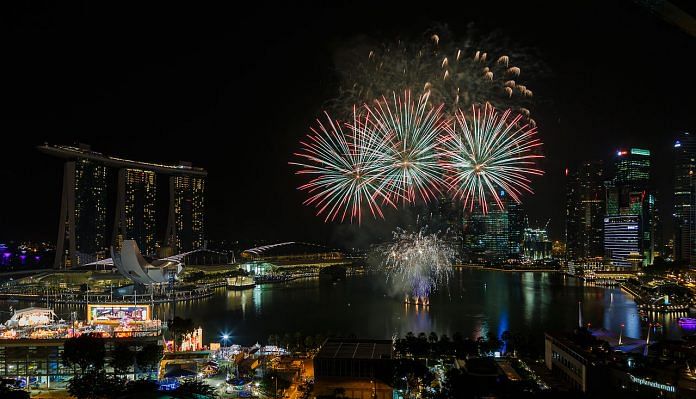Singapore’s former premier Lee Kuan Yew had a tough time balancing firecrackers and his First World aspirations in the 1960s, but here’s what he did.
The Supreme Court ban on the sale of firecrackers in the National Capital Region of Delhi is surely quite impractical, almost impossible to implement, if not a provocation for a thriving black market of firecrackers to mushroom this Diwali. And yet, it’s important to pause for a moment and not throw the baby out with the bathwater.
Firecrackers are a governance issue; one which comes with an aspirational quotient indexed to it. Just how?
Lee Kuan Yew, the legendary leader of Singapore, a role model of sorts for Prime Minister Narendra Modi, had a tough time dealing with firecrackers in the 1960s.
It turned into a major governance-cum-policy issue for Lee who, as Prime Minister, piloted a legislation in 1972 that eventually banned the use of firecrackers in Singapore. And this story, too, has a Chinese twist to it.
Bursting firecrackers was central to celebrating the Chinese New Year, just as it is to Diwali. Back in the 1960s, Singapore’s large, and reportedly somewhat unruly, Chinese population would take to the streets and lanes bursting firecrackers during this festive period.
There would be accidents, at times even small fires, at public places, and the usual crop of regular burn injuries. What troubled Lee was that this hazardous activity become somewhat of a norm with a flexible public safety threshold.
Now, Lee Kuan Yew followed a dictum to pursue policies that would distinguish Singapore from other Asian countries, one which also informed his vision to make Singapore aspire for First World standards – a governance journey documented in his book ‘From Third World to the First: The Singapore Story’. His encounter with the problem of firecrackers is narrated in the book, along with the set of initiatives he took to make Singapore clean and green.
He was convinced that the unruly, unregulated fireworks during the Chinese New Year festivities were a misfit to his First World aspirations for Singapore, even though they were hugely popular. In those days, the Singapore government apparently gave tax exemptions to companies that made these firecrackers.
But a beginning was made in 1968, when an order was issued to prohibit the use of some varieties of dangerous firecrackers. This proved ineffective. Then, in 1970, six people were killed in a fire caused by crackers, which led to some punitive measures being added to the regulations.
None of this helped until 1972, when a mob attacked a couple of unarmed policemen trying to stop the use of dangerous firecrackers. Lee is said to have then put his foot down. He went ahead and decided to ban firecrackers, despite all the mob pressure of the Chinese-origin population in Singapore.
The Dangerous Fireworks Act of 1972 is considered among the landmark efforts of Lee Kuan Yew. Through this legislation, the use, sale, transfer, and production of firecrackers was banned in Singapore.
According to the latest revision to the Act, an offender may face a penalty of up to Singapore $5,000, or up to two years’ imprisonment.
A provision was made for exemptions, which essentially allowed for special fireworks displays after due clearance by the authorities. After nearly three decades of the stringent imposition of the ban, the Singapore government has shown some leniency of late in granting permissions for such fireworks displays.
While there isn’t a case to replicate such stringency in Delhi or any other city, what’s important is to reflect on the aspirational virtue that motivated Lee Kuan Yew. It’s not so much about the use of firecrackers, but the way to go about it that is the issue.
The debate on the Supreme Court order, for all its valid criticism, has been buried by the political argument that this amounts to infringement of religious freedom and the right to celebrate festivals the way communities desire.
In doing so, the aspirational aspects that someone like Lee Kuan Yew sought to flesh out and build on have also been lost. While this isn’t a matter for the courts to settle, it surely is a governance objective worth reflecting upon, at a time when Prime Minister Modi is listing his agenda for a ‘New India’.
Also read: Few takers for Punjab govt’s ‘best’ solution to stubble burning




Our granddaughter, Ananya, is celebrating her first Diwali in Singapore. The wisdom and foresight of PM LKY gives her a chance to grow up with strong lungs.
Mass slaughter of cattle and goat
Poor public transportation infrastructure
And they find it is easiest to crack down on traditional fireworks for Diwali
First we should understand our nation is entirely difference from Singapore by size, population and culture. Here a lac and lac people are engaged in this fire work industry and we are one among ancient producer of fire works like China.
I thing we are unnecessarily worrying about our about this issue, I want to remember our friends can we debate about Chernobyl, and drop of world’s largest bom in this earth and many worst fire accedents caused for testing and actually by accident by super powers.
We are discussing burning of crackers a few days in a year, but actually I questing all can we stop or reduce using petroleum products, lignite and automic powers.
Actually this glaxy is amazing and its should repair itself and live millions of years. We only disappear but this glaxy will remain a million and million.